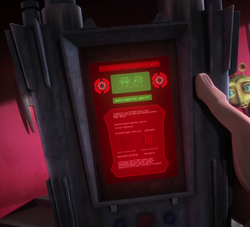Datascreen/Legends
A datascreen were devices that produced graphical displays of computer information. Various technologies were used to produce the images on datascreens. Likewise, the materials datascreens were made of varied greatly. Unlike three dimensional Hologram displays, datascreens displayed flat text or graphics. They were usually of a higher resolution than Hologram displays as well. Datascreens displays were preferred over holograms for various reasons. Portable devices like Datapads and Jedi testing screens usually had datascreens as opposed to holograms (although some had both options). Advertiscreens were often placed on city walls and near Hover car lanes to display information about commercial products. To save space, datascreens were preferred on bridges of most ships. Most often, several datascreens could be placed in the same space as a single hologram display.

A Data screen unit was a common unit of measurement based on how much information a datascreen could display. This depended on the size or resolution of the datascreen. Most datascreens were viewable from only one angle, however, some could be seen through like windows. These could display the information on both the front and back of the screen.
Datacards with specific information stored on them (for example, star charts, encyclopedias, tour guides, law books, works of fiction) were widely available. These datacards could then be loaded into the datapad for easy access. Many planetary governments were legally obligated to provide such materials (especially regarding local laws) to all offworlders.
Datapads also varied in size, from palm-sized devices to larger units designed for two hands. A common datapad was the Companion2000, which weighed less than 1 kg, and cost around 100 credits. It was produced by MicroData Technologies, which offered a wide range of datapad models.
Datapads were essential as notebooks. Revan and the Jedi Exile frequently used their datapads to take notes and store information concerning their missions and tasks.
Other uses of datapads included their employment by beings such as bounty hunters. Bounty hunters often used datapads to store mission information on their targets, locations, or other vital pieces of information. Personal Datapads of this kind were designed to erase all stored information if not handled correctly.
Behind the scenes
In many LucasArts games, an on-screen datapad interface is used to show the game menu, which includes inventory, mission objectives, level maps, and other information.
Graphical computer displays are present nearly every piece of visual Star Wars media (including comics, movies, and television shows). Most of the time they go unnamed. When they are referred to, they are most often called "datascreens" or "monitors"
Appearances
Sources
- Star Wars: The Roleplaying Game (as video screen)
- The Truce at Bakura Sourcebook
- The Rebel Alliance Sourcebook, Second Edition
- Secrets of the Sisar Run
- The Essential Guide to Weapons and Technology
- Star Wars Roleplaying Game Revised Core Rulebook
- Star Wars: The Complete Visual Dictionary
- The Official Star Wars Fact File 10 (DAT1-2, Datapads)
 "Secrets of Mos Eisley"—Star Wars Gamer 7
"Secrets of Mos Eisley"—Star Wars Gamer 7 "Thyferra: Bacta Basics" (original article link) on Wizards.com (content now obsolete; backup link)
"Thyferra: Bacta Basics" (original article link) on Wizards.com (content now obsolete; backup link) "Manaan: Depths of History" (original article link) on Wizards.com (content now obsolete; backup link)
"Manaan: Depths of History" (original article link) on Wizards.com (content now obsolete; backup link) "Beheboth: Blood and Water" (original article link) on Wizards.com (content now obsolete; backup link)
"Beheboth: Blood and Water" (original article link) on Wizards.com (content now obsolete; backup link)- File:SWGTCGsmall.jpg Star Wars Galaxies Trading Card Game – Squadrons Over Corellia
- The Complete Star Wars Encyclopedia
